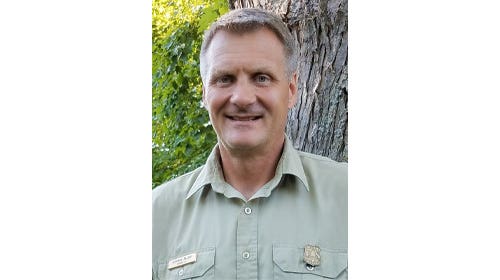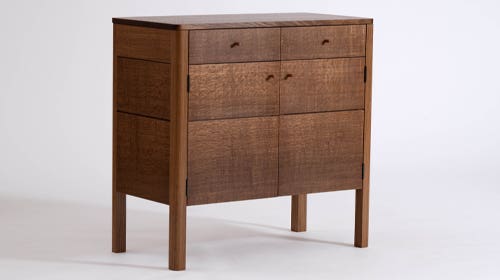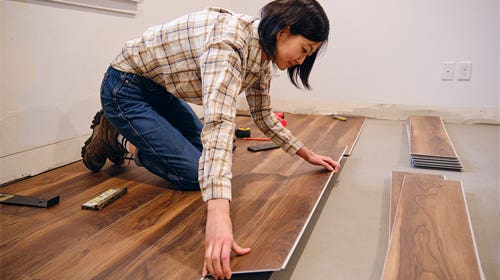He revels in restoration
Intense involvement with a good project is Greg Guenther’s definition of satisfaction. Along with his overloaded repertoire of faithful renditions of American and European period-style furniture from the 17th, 18th…
Intense involvement with a good project is Greg Guenther’s definition of satisfaction. Along with his overloaded repertoire of faithful renditions of American and European period-style furniture from the 17th, 18th and 19th centuries, Guenther also has successfully built a large clientele of museums, private individuals and dealers for furniture conservation.
The master craftsman founded Guenther Wood Group in 1980, a business for which he is committed to preserving the time-honored traditions of furniture making and traditional crafts. He and his skilled employees focus on an extensive range of styles from sleek modernism to Chippendale reproductions. Because the shop is situated in Savannah, Ga., a pristine and historic U.S. hub, location naturally influences Guenther’s desire to concentrate mainly on antique forms.
“I’m interested in all furniture. I’m interested in modern design and people that are doing those things, but in the Savannah area, historic furniture is our market,” says Guenther. “There’s the business side, and then there’s the art. The people who are interested in antiques tend to know one another. It’s all word of mouth. It’s been a practical decision to focus on antique furniture found in this coastal area full of house museums, collectors and a general interest in the past.”
The write stuff
Restoration accounts for about 60 percent of Guenther’s business. Recently; collectors of fine 20th century pieces — by designers such as Ruhlmann, Wright and Nakashima — have requested the careful restoration the studio is known for. The shop also receives commissions for strict replicas, loose reproductions and pieces inspired by a more modern twist.
Guenther, 55, is able to rest on his laurels of working with period-style pieces for more than 30 years, but still refers to his in-shop library, museums and online databases to accurately follow the same designs and dimensions, and use the same materials as the original artisans did in their time. By continually brushing up on his knowledge of period-style pieces, he pays sharp attention to design and details.
“I think I was fortunate, along with my generation of woodworkers, [to have] the number of publications that are out there for education and exposure,” says Guenther, adding that “Fine Points of Furniture: Early American,” by Albert Sack, is a must-read for any period furniture maker. “I have a lot of books that deal with historic pieces and I think, as I’ve read them cover to cover, that the scholarship on pieces and individual makers is definitely higher than it ever was with the amount of research and scientific studies that go on.”
From dreams to reality
While Guenther is talented, his sharp aesthetic judgment and keen ability to approach a wide variety of restoration and fine furniture commissions are learned skills that didn’t come overnight.
Guenther moved from his home state of New Jersey to Atlanta after high school and took up pre-engineering at Georgia Tech. He then enrolled at the University of Georgia, where he graduated with a bachelor’s degree in psychology, but went to work for an engineering company as a draftsman.
After marrying his college sweetheart, Victoria, in 1977, the couple moved to Savannah. He restored furniture for a local antique dealer and spent hours fixing loose joints and patching veneer. He enhanced his own skills by reading, and relied on his pre-engineering background to understand 3-D structures and drawings.
Two years later, Guenther decided to pursue furniture making on his own. He sectioned off a room in his house as a shop and worked on commissions for friends and acquaintances. This trial-and-error approach was supplemented with classes at the Penland School of Crafts in Penland, N.C., learning from the likes of Skip Johnson, Tage Frid and Wendell Castle, and by attending museum seminars and period furniture conferences.
A reliable clientele
Guenther admits he started rather cheaply and severely undercharged his first few dozen clients just to get more work. The plan was to become highly proficient at building historic pieces, and let the money take care of itself.
It was a good plan. He’s earned six-figure commissions and his shop has a steady backlog of work.
Most of the studio’s work emanates within a 300-mile radius, stretching north to Charleston, S.C., and west to Atlanta. Collectors, who have bought auction pieces at Sotheby’s and Christie’s, also find their way to Savannah.
Guenther has an interesting take on who he really works for. “The customer is the boss, but you hope the furniture itself is the ultimate boss,” he says. “But it’s very satisfying to have a client that comes in for a simple repair and then, five or six years later, commissions a major piece of furniture. That’s great. It means you’ve developed a long-term, trusting relationship.”
Museums, such as the Andrew Low House Museum in Savannah, are also a source of work. “For them, we conserved an interesting 1820s Joseph Barry and Son breakfront built in Philadelphia, shipped on a schooner to Savannah,” says Guenther. “It’s now valued as a half-million dollar piece.”
Fiddling with design
Period furniture makers often face ethical dilemmas when it comes to altering traditional styles and proportions. Today’s consumers need their oversized beds and their case pieces designed to accommodate modern necessities such as computers and flat screen TVs. Guenther is flexible, but will only go so far.
“I try not to do anything that’s irreversible, and if something is altered, it shouldn’t cause any damage to the period piece. By altering on a bed, for example, all the different components, such as the rails and posts, are detachable. So you can set aside a short rail, save those, and make longer rails so that people our size can sleep in it. So those alterations I agree with, but cutting a hole in the top of an old piece of furniture to put a sink in it — I totally disagree with that.”
Guenther does extensive research when he has a unique problem to solve and will pull in a specialist, if needed.
“I wanted, at first, to do everything myself; that was important to me. But now I realize that it can be a great advantage to the project to work with people who know a lot more and can add their input and skills. Conservator Roger White, who works here, is one of the best French polishers around and has solved many tricky finish problems for customers.”
Subcontractors include Mary May, a carver from Charleston, S.C., guilder Michael O’Brien and upholsterers Ross Sheehan and Richard Waters, all from Savannah.
Ideal business location
Guenther’s shop is housed in a two-story, 5,000-sq.-ft.,19th-century building, opened up as one main floor with high ceilings. Right in the middle of the Savannah historic district, it is only a block away from his home. He rented the facility as part of a co-op in 1985 and now owns the building.
A charming entryway enhanced with natural light makes a good first impression to clients who can walk in to see earnest artisans meticulously using traditional woodworking methods on historic pieces. A central staircase leads to an office loft, where Guenther retreats into bookwork and designing. The remainder of the facility is divided into a large machinery room, finishing room and display room nicknamed the “Halfway House,” where pieces are stored before work begins.
Though hand tools are used most frequently here, Guenther has a good $60,000 invested in machinery, including a Laguna 18" band saw, JET wide belt sander, General drum sander, Multi-Router, Powermatic table saw, Felder joiner/planer and sliding table saw, Bridgewood planer, Delta lathe and drill press, and SECO dust collector.
CNC machinery isn’t really a matter of discussion here. Guenther does, however, hope to get an upgraded centralized dust collection system in the near future.
The labor is so intensive, working with great material only makes sense. Guenther uses exceptional lumber, including wide boards cut from the same tree. He gets his tiger maple, walnut, claro walnut, cherry, curly cherry, and other figured hardwoods from suppliers such as Groff and Groff Lumber Inc. of Quarryville, Pa., and Good Hope Hardwoods of Landenberg, Pa. He often gets his veneers from Certainly Wood in East Aurora, N.Y.
His employees include White, a British conservator who trained at West Dean in Sussex, England, and specializes in all aspects of historic finishes and woodworking treatments; and furniture designers Jason Wech and Jason Thackeray, graduates of the Savannah College of Art and Design. Mary Mistak works part-time in the office.
Networking pays off
Guenther has a plethora of studio and museum recognition under his belt, including a Goddard Townsend breakfront six-shell secretary that was part of the Society of American Period Furniture Makers’ exhibit in 2006 at the Telfair Museum of Art in Savannah. Guenther credits master furniture maker Allan Breed for supplying full-scale drawings and discussing critical construction details.
By chance, Guenther was working on the secretary when Leslie and Leigh Keno (hosts of “Antiques Roadshow”) came to town in 2004. Guenther has also been featured on HGTV’s “Modern Masters” series.
In 2006, he hosted a demonstration by Philippe Raymond, a French marquetry expert, and has made presentations for the National Trust for Historic Preservation, National Society of the Colonial Dames, and The Furniture Society.
He’s also a supporter and member of the Museum of Early Southern Decorative Arts, Society of American Period Furniture Makers, and American Institute for Conservation of Historic Works of Art, which lays down the law on how classic furniture should be approached.
“The ongoing exchanges, ideas and opportunities have always surprised me,” says Guenther. “Through the Wooden Artifacts Group, I had the opportunity to study French furniture and conservation practices in France. What an experience.”
Members of theses organizations also help Guenther provide additional services to his clients, including written and photographic documentation, object surveys, and wood and finish micro-analysis. Some clients care deeply about the lineage of their furniture, and others not so much. He is prepared either way.
“I’d say 50 percent of our customers are really interested in the quality and authenticity of the pieces they buy. The others are mostly interested in the look, but want to correctly maintain the value.”
Guenther has two children — a son who’s interested in composing music and a daughter still in college — and doesn’t foresee either of them following in his footsteps. As for the next step, Guenther is comfortable with his small-scale operation and doesn’t plan to expand.
“I’m always looking for the more serious furniture clients, whether they’re the design-build type or the collectors.”
Contact: Guenther Wood Group, 409 E. York St., Savannah, GA 31401. Tel: 912-447-5522. www.guentherwoodgroup.com







